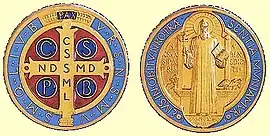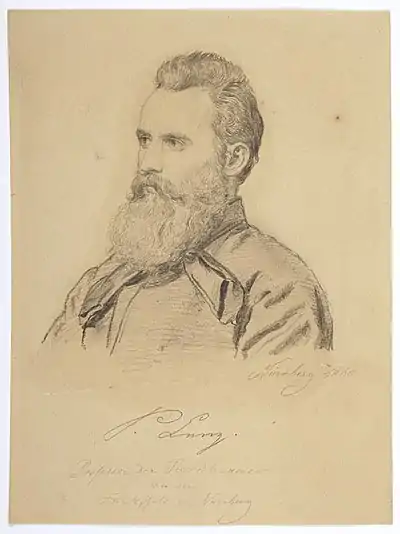Desiderius Lenz
Peter Lenz (1832–1928), afterwards Desiderius Lenz, was a German artist who became a Benedictine monk and together with Gabriel Wüger was a founder of the Beuron Art School.[1] Peter was his birth name, but Desiderius became his name when he entered religious orders in 1872. The name was presumably given in reference to the eleventh-century Abbot Desiderius of the Abbey of Monte Cassino, the source of the Benedictine Order.

Background
Peter Lenz was born in 1832 in Haigerloch, Baden-Württemberg. From 1849 he studied at the Academy of Fine Arts, Munich as a pupil of the painter and sculptor Max von Widnmann and the muralist Wilhelm von Kaulbach, where he learnt about ancient Greek art, medieval German painting and artists of the Italian Renaissance. In 1851 he joined the Union of Artist Pupils at the Academy, and met Jakob Wüger. Although of differing characters, the two became friends and worked together.[2]

Peter von Cornelius was a significant figure in Lenz's artistic development, and promoted his career. Cornelius had engaged in the Nazarene Brotherhood or Lukasbund at Rome between 1811 and 1819, where he worked with Friedrich Wilhelm Schadow, a Lutheran convert to Roman Catholicism and founder of the Düsseldorf school of painting. Schadow taught that the spiritual life of the artist must be invested in the truths of Christian art.[3] Cornelius was Director of the Munich Academy c.1825-40, and exercised a powerful influence there from which Lenz and Wüger benefited.[4]
After working in Meiningen in 1855-56, and then back in Munich as an independent sculptor, in 1859 Lenz became Professor of Sculpture at the School of Applied Art in Nuremberg. Not long afterwards, on the recommendation of Cornelius, he received a State-funded stipend to work in Italy. In 1863 he went to Rome with Jakob Wüger and Wüger's pupil Fridolin Steiner to work with artists of the Nazarene movement.[5]
Search for religious principles
Lenz deplored the fact that the modern art of his time had become directionless in the high value which it set upon Naturalism and the empty matter of individual preference. He had realized that the painstaking imitation of Nature alone would never lead to work having the quality of the Antique. Study of the work of the early Christian and Byzantine artists, and of Giotto, taught him that geometry and the arrangement of parts were essential factors in what he sought to achieve, but he lacked a key to their understanding. The early Christian works represented the tail end of a tradition, and Giotto had been guided by his instincts, but the old Greek masters seemed to have worked to definite artistic principles and rules of proportion, which he resolved to rediscover.
Investigation of Greek vase painting led him to the work of the archaeologist Lepsius on the construction and ornamentation of Egyptian temples, in which he found answers. His inborn feeling for number and symmetry, for arrangement and equilibrium, responded to the idea that in Art, as in music, the secret of beauty was numerical, both arithmetical and geometrical. It was brought about by the conjunction of logic with principles of symmetry and harmony of proportions. This insight accorded with his own religiosity: the Egyptian wisdom had been a taking-hold of the spirit, a taming of uncultivated things and an arousing of awe in Mystery.[6]
Beuron
Although Wüger was of a Calvinist background both he and the more idealistic Lenz moved to the belief that artists should work together in a Catholic community to produce Sacred Art suitable for the devotional and liturgical environment. Around 1866 a plan for an 'Ideal Church' was produced, and in 1868 they met Maurus Wolter, the first abbot of the Benedictine Archabbey of Beuron founded in 1863 under the patronage of Princess Katherina von Hohenzollern. Wolter was already engaged in the revival of Gregorian chant, after the model of Solesmes Abbey,[7] and also wished his abbey to play its part in the revival of religious art.
Lenz first visited the Archabbey of Beuron (dedicated to St Martin) in January 1868, aged 36, drawn by the Gregorian revival and its relevance to his own quest. The Fürstin von Hohenzollern had promised to endow a Chapel to St Maurus (the original disciple of St Benedict) and Lenz, having explained his artistic aims, produced a plan for it which was accepted and built. Returning to Rome to obtain Wüger's involvement, the cartoons for the painting were prepared, and together with Fridolin Steiner they returned to Beuron in May 1869. The work was completed in summer 1871 and the Chapel of St Maurus in the Fields was dedicated in September. Wüger took on the robes of the Order at Beuron in September 1871 as Brother Gabriel, followed by Steiner as Brother Lukas (perhaps with reference to the Lukasbund) and finally Lenz as Brother Desiderius in 1872.[8] The Chapel became the Cradle of the Beuron Art School.
Writings
- Naturstudium des Alten (A Study of the Nature of the Ancients), 1895 (not published).
- Zur Ästhetik der Beuroner Schule (Vienna 1898). (2nd. Edition, Beuron 1927). Internet archive
- Desiderius Lenz: The Aesthetic of Beuron, and other writings. Translated from the German by John Minahane and John Connolly. Introduction and Appendix by Hubert Krins. Afterword and notes by Peter Brooke. (Francis Boutle publishers, London 2002). ISBN 0-903427-10-9
- Ästhetik, Geometrie und kirchliche Kunst, 1914 (not published)
- 'Der Kanon', in Benediktinische Monatsschrift 3 (1921), pp. 363–77.
- Festschrift und Festgedichte zum 80. Geburtstage unseres Altreichskanzlers Otto von Bismarck (Heidenheim 1895).
Sources
- Odilo Wolff OSB, 'Beuroner Kunst', in Die Christliche Kunst, Monatschrift für alle Gebiete der Christlichen Kunst, 7th Year 1910-11 (Gesellschaft für Christliche Kunst, Munich), pp. 121–149. Internet archive (German, illustrated).
- Josef Kreitmaier S.J., Beuroner Kunst: eine Ausdrucksform der Christlichen Mystik 4th and 5th Edition (Herder & Co., Freiburg im Breisgau 1923). Internet archive
- Maurus Pfaff (Pater Dr.), O.S.B., P. Desiderius Peter Lenz, der Meister von Beuron 1832 - 1928; Persönlichkeit und Werk (Beuroner Kunstverlag, 1978). (from: Erbe und Auftrag, 54,3).
- Gallus Schwind, P. Desiderius Lenz. Biographische Gedenkblätter zu seinem 100. Geburtstag (Beuron/Hohenzollern 1932).
- Harald Siebenmorgen, Die Anfänge der "Beuroner Kunstschule": Peter Lenz und Jakob Wüger, 1850 - 1875; ein Beitrag zur Genese der Formabstraktion in der Moderne (Thorbecke, Sigmaringen 1983). ISBN 3-7995-5028-3. (Freiburg (Breisgau), Diss., 1979).
- Harald Siebenmorgen, 'Lenz, Peter', in Neue Deutsche Biographie (NDB) Vol. 14 (Duncker & Humblot, Berlin 1985), ISBN 3-428-00195-8, pp. 234 ff. (Digitalized).
- Velten Wagner (Ed.), Avantgardist und Malermönch. Peter Lenz und die Beuroner Kunstschule, Catalogue to the Exhibition 'Avantgardist und Malermönch: Peter Lenz und die Beuroner Kunstschule', Städtisches Museum Engen 2007 (Quensen, Hildesheim 2007). ISBN 978-3-938816-03-5.
See also
Notes
- The Revival of Medieval Illumination: Nineteenth-Century Belgium Manuscripts and Illuminations from a European Perspective by Thomas Coomans and Jan De Maeyer 2007 ISBN 90-5867-591-2 page 144
- C. Rius, 'The Work of Peter Lenz' in Antoni Gaudí: Casa Bellesguard as the Key to his Symbolism (Edicions Universitat Barcelona 2014), p. 45, citing Martha Dreesbach, 'Pater Desiderius Lenz OSB, Theorie und Werke. Zur Wesensbestimmung der Beuroner Kunst' (Phil. Dissertation, Munich 1957), pp. 12-24; Gallus Schwind, P. Desiderius Lenz. Biographische Gedenkblätter zu seinem 100. Geburtstag (Beuron/Hohenzollern 1932).
- F.W. Schadow, Über den Einfluss des Christentums auf die bildende Kunst, Vorlesung gehalten am 30 September 1842 vor der General-Versammlung des Congrės Scientifique zu Strassburg (Düsseldorf, 1842).
- O. Wolff, 'Beuroner Kunst', p. 123; Rius, 'The Work of Peter Lenz', p. 45, note ii.
- H. Siebenmorgen, "Lenz, Peter" in Neue Deutsche Biographie 14 (1985), p. 234 ff.
- W. Verkade, Die Unruhe zu Gott (Herder & Co., Freiburg im Breisgau 1930 edition), pp. 203-04. This summary is based on Lenz's reported words to Verkade at their meeting at the start of 1894.
- Examples of the Gregorian Chant as performed by the monks of the Abbey of St Martin, Beuron, under the direction of Pater Dr. Maurus Pfaff O.S.B., were recorded by Deutsche Grammophon Gesellschaft, see a discography here.
- W. Verkade, Die Unruhe zu Gott (Herder & Co., Freiburg im Breisgau 1930 edition), pp. 204-06.
External links
| Wikimedia Commons has media related to Desiderius Lenz. |
- Carles Rius, 'The Life and Work of Peter Lenz', in Antoni Gaudí: Casa Bellesguard as the Key to his Symbolism (Edicions Universitat Barcelona 2014), pp. 45 ff. (English, incomplete text preview).
- F. Mazzaferro (Translator), 'Desiderius Lenz, Canone divino. L’arte e la regola della scuola di Beuron, Edited by Paolo Martore', Part One (Castelvecchi, 2015). Letteratura Artistica website
